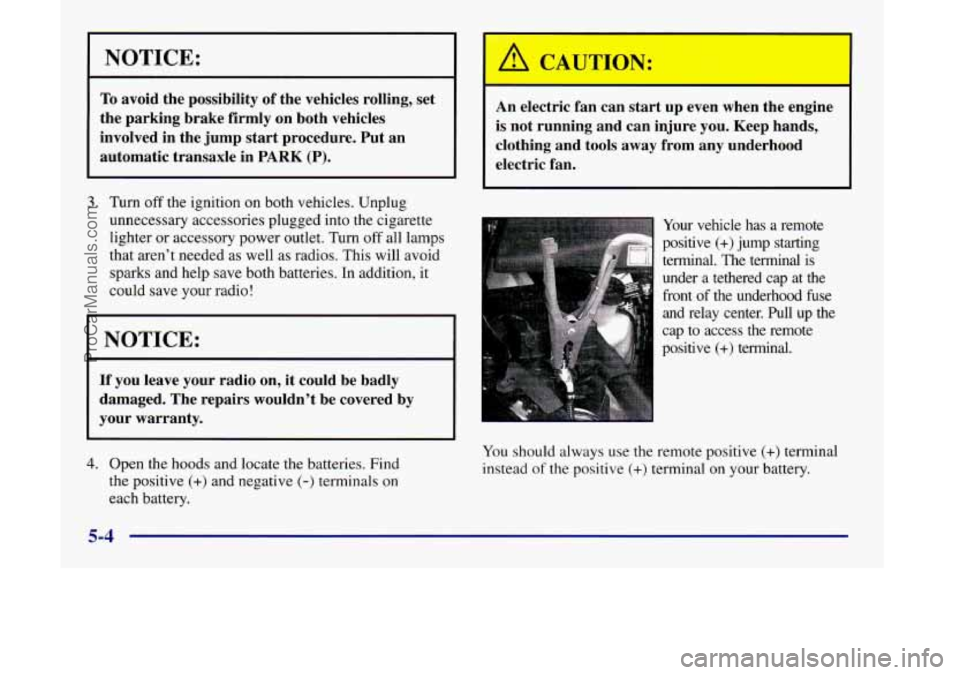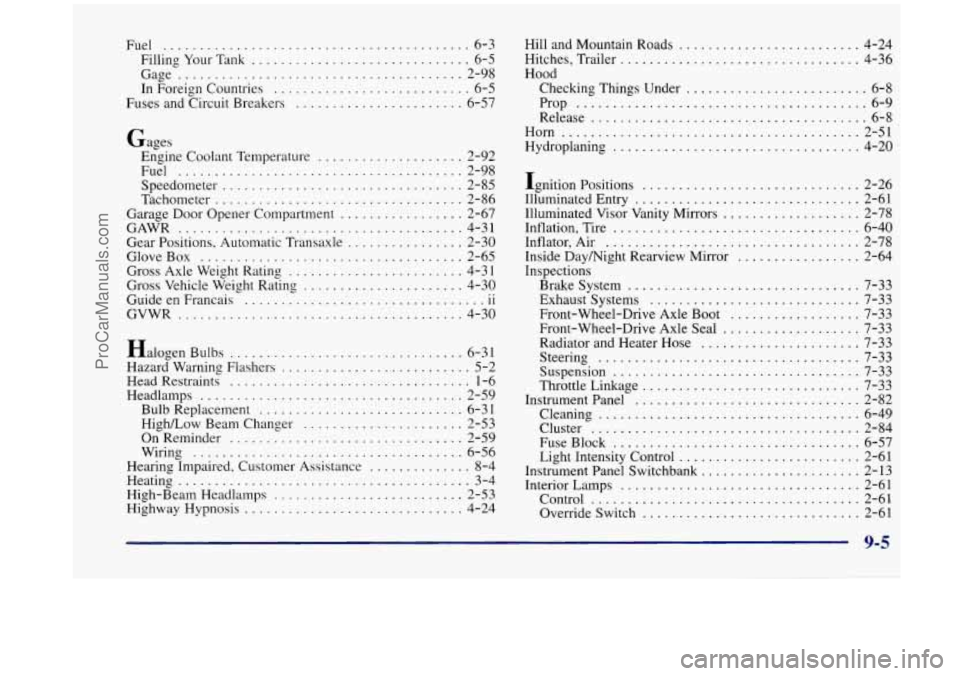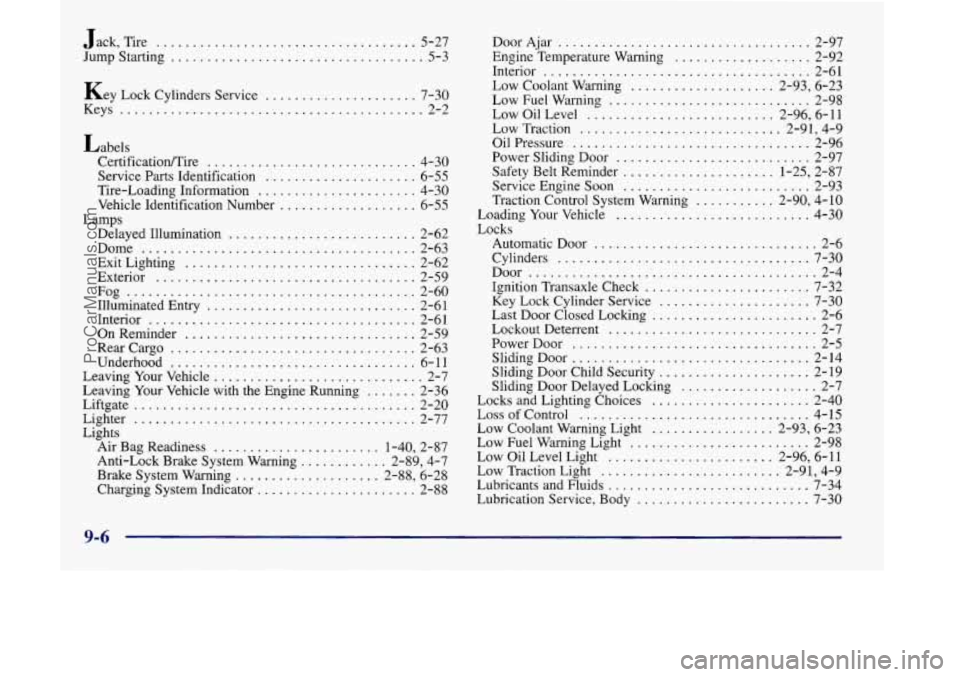ignition OLDSMOBILE SILHOUETTE 1998 Workshop Manual
[x] Cancel search | Manufacturer: OLDSMOBILE, Model Year: 1998, Model line: SILHOUETTE, Model: OLDSMOBILE SILHOUETTE 1998Pages: 444, PDF Size: 23.2 MB
Page 230 of 444

Care of Your Cassette Tape Player
A tape player that is not cleaned regularly can cause
reduced sound quality, ruined cassettes or a damaged
mechanism. Cassette tapes should be stored in their
cases away from contaminants, direct sunlight and
extreme heat. If they aren’t, they may not operate
properly or may cause failure of the tape player.
Your tape player should be cleaned regularly after every
50 hours of use. Your radio may display CLN to indicate
that you have used your tape player for
50 hours without
resetting the tape clean timer. If this message appears
on
the display, your cassette tape player needs to be
cleaned. It will still play tapes, but you should clean it as
soon as possible to prevent damage to your tapes and
player.
If you notice a reduction in sound quality, try a
known good cassette to see if it
is the tape or the tape
player at fault. If this other cassette has no improvement
in sound quality, clean the tape player.
The recommended cleaning method for your cassette
tape player
is the use of a scrubbing action,
non-abrasive cleaning cassette with pads which scrub
the tape head as the hubs of the cleaner cassette turn.
The recommended cleaning cassette
is available through
your retail facility
(GM Part No. 12344789). When using a
scrubbing action, non-abrasive cleaning
cassette, it is normal for the cassette to eject because
your unit is equipped with a cut tape detection feature
and a cleaning cassette may appear as a broken tape.
To
prevent the cleaning cassette from being ejected, use the
following steps.
1. Turn the ignition to RUN or ACCESSORY.
2. Turn the radio off.
3. Press and hold the TAPE AUX button for five
seconds. The tape symbol on the display will flash
for two seconds.
4. Insert the scrubbing action cleaning cassette.
5. Eject the cleaning cassette after the manufacturer’s
recommended cleaning time.
When the cleaning cassette has been ejected, the cut tape
detection feature is active again.
You may also choose a non-scrubbing action, wet-type
cleaner which uses a cassette with a fabric belt to clean
the tape head. This type of cleaning cassette will not
eject on its own.
A non-scrubbing action cleaner may
not clean as thoroughly as the scrubbing type cleaner.
The use of a non-scrubbing action, dry-type cleaning
cassette is not recommended.
3-26
ProCarManuals.com
Page 239 of 444

Avoid needless heavy braking. Some people drive in
spurts
-- heavy acceleration followed by heavy
braking
-- rather than keeping pace with traffic. This is a
mistake. Your brakes may not have time to cool between
hard stops. Your brakes will wear out much faster if you
do a lot
of heavy braking, If you keep pace with the
traffic and allow realistic following distances,
you will
eliminate a lot of unnecessary braking. That means
better braking and longer brake life.
If your engine ever stops while you’re driving, brake
normally but don’t pump your brakes. If you
do, the
pedal may get harder
to push down. If your engine
stops, you will still have
some power brake assist. But
you will use
it when you brake. Once the power assist is
used up, it may take longer to stop and the brake pedal
will be harder to push.
Anti-Lock Brakes (ABS)
Your vehicle has anti-lock brakes (ABS). ABS is an
advanced electronic braking system that will help
prevent a braking skid.
When you start your engine, or when you begin to drive
away, your anti-lock brake system will check itself. You
may hear
a momentary motor or clicking noise while
this test is going on, and
you may even notice that your
brake pedal moves
a little. (You may also hear a clicking
noise if you leave the ignition in the
RUN position for
about four seconds before starting the vehicle.) This
is normal.
If there’s a problem with the
anti-lock brake system, this
warning light will stay on or
flash. See “Anti-Lock
Brake System Warning
Light’’ in the Index.
ProCarManuals.com
Page 257 of 444

If you drive regularly in steep country, or if you’re
planning to visit there, here are some tips that can make
your trips safer and more enjoyable.
Keep your vehicle in good shape. Check all fluid
levels and also the brakes, tires, cooling system
and transaxle. These parts can work hard on
mountain roads.
Know how to go down hills. The most important
thing to know is this: let your engine do some
of the
slowing down. Shift to a lower gear when you go
down a steep or long hill.
L
CAUTION:
If you don’t shift down, your brakes could
get
so hot that they wouldn’t work well. You
would then have poor braking or even none going
down a hill. You could crash. Shift down to let
your engine assist your brakes on a steep
downhill slope. Coasting downhill
in NEUTRAL (N) or with
the
ignition
off is dangerous. Your brakes wiU have to
do
all the work of slowing down. They could get so
hot that they wouldn’t work well. You would then
have poor braking or even none
going down a hill.
You could crash. Always have your engine running
and your vehicle in gear when you go downhill.
Know how to go uphill. You may want to shift down
to a lower gear. The lower gears help cool your engine
and transaxle, and
you can climb the hill better.
Stay in your own lane when driving on two-lane
roads in hills or mountains. Don’t swing wide or cut
across
the center of the road. Drive at speeds that let
you stay in your own lane.
0 As you go over the top of a hill, be alert. There could be
something in your lane, like a stalled
car or an accident.
You may see highway signs on mountains that warn of
special problems. Examples are long grades, passing or
no-passing zones, a falling rocks area or winding
roads. Be alert to these and take appropriate action.
4-25
ProCarManuals.com
Page 278 of 444

NOTICE:
To avoid the possibility of the vehicles rolling, set
the parking brake firmly on both vehicles
involved in the jump start procedure. Put an
automatic transaxle in
PARK (P).
3. Turn off the ignition on both vehicles. Unplug
unnecessary accessories plugged into the cigarette
lighter or accessory power outlet. Turn
off all lamps
that aren’t needed as well as radios. This will avoid
sparks and help save both batteries.
In addition, it
could save your radio!
I NOTICE:
If you leave your radio on, it could be badly
damaged. The repairs wouldn’t be covered by
your warranty.
JTION:
--
An electric fan can start up even when the engine
is not running and can injure you. Keep hands,
clothing and tools away from any underhood
electric fan.
Your vehicle has a remote
positive
(+) jump starting
terminal. The terminal is
under a tethered cap at the
front of the underhood fuse
and relay center. Pull up the
cap to access the remote
positive
(+) terminal.
4. Open the hoods and locate the batteries. Find
the positive
(+) and negative (-) terminals on
each battery. You
should always use
the remote positive (+) terminal
instead
of the positive (+) terminal on your battery.
5-4
ProCarManuals.com
Page 348 of 444

5. Replace the bulb(s) by pulling the old one(s) out
and gently pushing the
new one(s) into the bulb
holder socket.
7. Reinstall the taillamp assembly by inserting the
outboard locatingketaining pins until the lamp is
seated. Secure with the inboard screws.
For any bulb changing procedure not listed in this
section, contact your retailer service department.
Windshield Wiper
Blade Replacement
For the proper windshield wiper blade length and type,
see “Replacement Parts” in the Index.
Replacement blades come in different types
and are
removed
in different ways. Here’s how to remove the
type with a release clip:
1. Turn the wipers on to the lowest intermittent setting.
2. Turn off the ignition while the wipers are at the
outer positions of the wipe pattern. The blades are
more accessible for removalheplacement while in
A. Tail Bulb C. Turn Signal Bulb
B. Back-up Bulb D. Stop/Tail Bulb this position.
6. Snap the bulb holder back into place making sure all
retaining tabs
are properly over the bulb holder tabs.
3. Pull the windshield wiper arm away from the
windshield
or backglass.
6-38
ProCarManuals.com
Page 372 of 444

Maxi Fuse
5-IGN MAIN 1
6-COOL FAN 1
7-BATT MAIN
1
8-IGN MAIN 2
Ignition Switch to Fuses (UP):
ABS/TCS IGN, CRUISE, DRL,
ELEC PRNDL, IGN
1, PSD,
SIR, T/SIG and PCM [IGN
MAIN Relay (Underhood
Electrical Center Fuses: A/C
INJ, TCC)]
CLU, ELEK IGN, IGN 1-U/H,
Coolant
Fans
Fuses
(UP): ABS MOD BATT,
CIGARIDLC, CTSY LAMP,
FRT PWR SCKT, PWR LOCK,
PWR MIRROR and RR
PWR SCKT
Ignition Switch to Fuses
(UP):
BCM PRGRM, FRT HVAC
LOWIMED BLWR, FRT
WPRNSHR, HVAC/DRL,
MALL/RADIO/DIC, PWR
QRT VENT, RR HVAC, RR
WPRNSHR, SUNROOF,
SWC ACCY and PWR WDO
Circuit Breaker
Mini Relays
9-COOL FAN
10-COOL FAN
2
1 1 -1GN MAIN
12-COOL
FAN 1
Micro Relays
13-A/C CLU
14-FUEL PUMP
l5-F/PMP SPD
CONT
16-HORN
17-FOG LAMP
Mini Fuse
18-INJ
19-SPARE
20-SPARE RH
FAN
1, LH FAN 2
LH FAN 2
FUSES: A/C CLU, IGN l-U/H,
INS, ELEK IGN, TCC
RH FAN
1, LH FAN 2
A/C Clutch
Fuel Pump
Not Used
Horn
LH Fog Lamp, RH Fog Lamp,
Fog Lamp Indicator
Fuel Injectors 1-6
Not Used Not Used
6-62
ProCarManuals.com
Page 373 of 444

Mini Fuse
2 1 -1GN 1 -UH
22-SPARE
23-SPARE
24-SPARE
25-ELEK
IGN
26-SPARE
27-B/U LAMP
28-NC CLU
29-RADIO Evaporative Emissions
(EVAP)
Canister Purge Valve, Heated
Oxygen Sensors
1 and 2, Mass
Air Flow (MAF) Sensor
Not Used
Not Used
Not Used
Ignition Control Module (ICM)
Not Used
Transaxle Range Switch to
Back-up Lamps
A/C CLU Relay to A/C
Compressor Clutch Oil
Driver Information Display,
Heater A/C Control, Radio,
Rear Side Door Actuator
Control Motor, Remote Control
Door Lock Receiver (RCDLR),
Security Indicator Lamp and
Theft Deterrent Shock Sensor
Mini Fuse
30-ALT SENSE
3
1 -TCC Generator
Automatic Transaxle
(Torque
Converter Clutch Solenoids)
Stoplamp Switch to PCM
32-FUEL PUMP Fuel Pump Relay
33-ECM SENSE
34
35-FOG LP
36-HORN
37-PARK LP
38
39
40 Powertrain Control
Module (PCM)
Not Used
Fog Lamp Relay
Horn Relay
Daytime Running Lamps (DRL) Control Module,
Headlamps and
I/P Dimmer
Switch Theft-Deterrent Relay
to Headlamps
Not Used
Not Used
Mini Fuse Puller
6-63
ProCarManuals.com
Page 408 of 444

Ignition Transaxle Lock Check
While parked, and with the parking brake set, try to turn
the ignition key to LOCK in each shift lever position.
The key should turn to LOCK only when the shift
0 The key should come out only in LOCK.
lever is in
PARK (P).
Parking Brake and Automatic Transaxle E
Merhnnism Check
When you are doing
this check, your vehicle
could begin to move. You or others could be
injured and property could be damaged. Make
sure there
is room in front of your vehicle in case
it begins to roll. Be ready to apply the regular
brake
at once should the vehicle begin to move.
Park on a fairly steep hill, with the vehicle facing
downhill. Keeping your foot on the regular brake, set the
parking brake.
0 To check the parking brake’s holding ability: With
the engine running and transaxle in NEUTRAL
(N),
slowly remove foot pressure from the regular brake
pedal.
Do this until the vehicle is held by the parking
brake only.
0 To check the PARK (P) mechanism’s holding ability:
With the engine running, shift to PARK (P). Then
release all brakes.
Underbody Flushing Service
At least every spring, use plain water to flush any
corrosive materials from the underbody, Take care to
clean thoroughly any areas where mud and other debris
ProCarManuals.com
Page 431 of 444

Fuel .......................................... 6-3
Filling Your Tank
.............................. 6-5
In Foreign Countries
........................... 6-5
Fuses and Circuit Breakers
....................... 6-57
Gage
....................................... 2-98
Gages Engine Coolant Temperature
.................... 2-92
Fuel
....................................... 2-98
Speedometer
................................. 2-85
Tachometer
.................................. 2-86
Garage Door Opener Compartment
................. 2-67
Gear Positions. Automatic Transaxle
................ 2-30
GloveBox
.................................... 2-65
Gross Axle Weight Rating ........................ 4-31
Gross Vehicle Weight Rating
...................... 4-30
Guide en Francais
11
GAWR ....................................... 4-31
.. .................................
GVWR ....................................... 4-30
Halogen Bulbs
................................ 6-31
Hazard Warning Flashers
.......................... 5-2
Head Restraints ................................. 1-6
Headlamps
.................................... 2-59
Bulb Replacement
............................ 6-3 1
On Reminder ................................ 2-59
Wiring
..................................... 6-56
Hearing Impaired. Customer Assistance
.............. 8-4
Heating
........................................ 3-4
High-Beam Headlamps
.......................... 2-53
Highway Hypnosis
.............................. 4-24
High/Low Beam Changer ...................... 2-53 Hill
and Mountain Roads
......................... 4-24
Hitches. Trailer
................................. 4-36
Hood Checking Things Under
......................... 6-8
Prop
........................................ 6-9
Release
...................................... 6-8
Horn
......................................... 2-51
Hydroplaning
.................................. 4-20
Ignition Positions
.............................. 2-26
Illuminated Entry
............................... 2-61
Illuminated Visor Vanity Mirrors
................... 2-78
Inflation. Tire
.................................. 6-40
Inflator. Air
................................... 2-78
Inside Daymight Rearview Mirror
................. 2-64
Inspections Brakesystem
................................ 7-33
Exhaust Systems
............................. 7-33
Front-Wheel-Drive Axle Boot
.................. 7-33
Front-Wheel-Drive Axle Seal
................... 7-33
Radiator and Heater Hose
...................... 7-33
Steering
.................................... 7-33
Suspension
.................................. 7-33
Throttle Linkage .............................. 7-33
Instrumentpanel
............................... 2-82
Cleaning
.................................... 6-49
Cluster
..................................... 2-84
FuseBlock
.................................. 6-57
Light Intensity Control
......................... 2-61
Instrument Panel
S witchbank ...................... 2-13
Interior Lamps
................................. 2-61
Control
..................................... 2-61
OverrideSwitch
.............................. 2-61
ProCarManuals.com
Page 432 of 444

Jack. Tire .................................... 5-27
Jump Starting
................................... 5-3
Key Lock Cylinders Service ..................... 7-30
Keys
.......................................... 2-2
Labels CertificationRire
............................. 4-30
Service Parts Identification
..................... 6-55
Tire-Loading Information
...................... 4-30
Vehicle Identification Number
................... 6-55
Delayed Illumination
.......................... 2-62
Dome
...................................... 2- 63
Exit Lighting
................................ 2-62
Exterior
.................................... 2-59
Fog
........................................ 2-60
Illuminated Entry
............................. 2-6 1
Interior
..................................... 2- 61
OnReminder ................................ 2-59
Rearcargo
.................................. 2-63
Underhood
.................................. 6-11
Leaving Your Vehicle
............................. 2-7
Leaving Your Vehicle with the Engine Running
....... 2-36
Liftgate
....................................... 2- 20
Lirrhter ....................................... 2-77
Lamps
Lights
Air Baa Readiness ....................... 1.40. 2.87
Anti-LGck Brake System Warning
............ 2.89. 4.7
Brake System Warning
.................... 2.88. 6.28
Charging System Indicator
...................... 2-88 DoorAjar
................................... 2-97
Engine Temperature Warning
................... 2-92
Interior
..................................... 2-61
Low Coolant Warning
.................... 2.93, 6.23
Low Fuel Warning
............................ 2-98
Low Oil Level
.......................... 2.96. 6. 11
Low Traction
............................ 2.91. 4.9
Oil Pressure
................................. 2-96
Power Sliding Door
........................... 2-97
Safety Belt Reminder
..................... 1-25, 2.87
Service Engine Soon
.......................... 2-93
Traction Control System Warning
........... 2-90. 4-10
Loading Your Vehicle ........................... 4-30
Automatic Door
............................... 2-6
Cylinders
................................... 7-30
Door
........................................ 2.4
Ignition Transaxle Check
....................... 7-32
Key Lock Cylinder Service
..................... 7-30
Last Door Closed Locking
....................... 2-6
Lockout Deterrent
............................. 2-7
PowerDoor
.................................. 2-5
Sliding Door
................................. 2-14
Sliding Door Child Security
..................... 2-19
Sliding Door Delayed Locking
................... 2-7
Locks and Lighting Choices
...................... 2-40
Loss of Control
................................ 4-15
Low Coolant Warning Light
................. 2-93, 6-23
Low Fuel Warning Light
......................... 2-98
Low Oil Level Light
....................... 2-96, 6-11
Low Traction Light
......................... 2-91, 4-9
Lubricants and Fluids
............................ 7-34
Lubrication Service. Body
........................ 7-30
Locks
9-6
. ..
ProCarManuals.com